Deck 3: Motion in Two and Three Dimensions
Question
Question
Question
Question
Question
Question
Question
Question
Question
Question
Question
Question
Question
Question
Question
Question
Question
Question
Question
Question
Question
Question
Question
Question
Question
Question
Question
Question
Question
Question
Question
Question
Question
Question
Question
Question
Question
Question
Question
Question
Question
Question
Question
Question
Question
Question
Question
Question
Question
Question
Question
Question
Question
Question
Question
Question
Question
Question
Question
Question
Question
Question
Question
Question
Question
Question
Question

Unlock Deck
Sign up to unlock the cards in this deck!
Unlock Deck
Unlock Deck
1/67
Play
Full screen (f)
Deck 3: Motion in Two and Three Dimensions
1
The displacement of a particle is _______ the distance the object has traveled.
A) larger than
B) smaller than
C) either larger or smaller than
D) the same as
E) smaller than or equal to
A) larger than
B) smaller than
C) either larger or smaller than
D) the same as
E) smaller than or equal to
smaller than or equal to
2
A vector has an x component of -5.51 units and a y component of +9.52 units. The angle between the positive direction of the vector and the positive direction of the x axis is
A) 125º
B) 60º
C) 120º
D) 150º
E) -60º
A) 125º
B) 60º
C) 120º
D) 150º
E) -60º
120º
3
A river is 0.76 km wide. The banks are straight and parallel. The current is 5.0 km/h and is parallel to the banks. A boat has a maximum speed of 3 km/h in still water. The pilot of the boat wishes to travel on a straight line from A to B, where AB is perpendicular to the banks. The pilot should
A) head directly across the river.
B) head 68º upstream from the line AB.
C) head 22º upstream from the line AB.
D) give up. The trip from A to B is not possible with this boat.
E) do none of these.
A) head directly across the river.
B) head 68º upstream from the line AB.
C) head 22º upstream from the line AB.
D) give up. The trip from A to B is not possible with this boat.
E) do none of these.
give up. The trip from A to B is not possible with this boat.
4
A vector has an x component of 5.51 units and a y component of -9.52 units. The angle between the positive direction of the vector and the positive direction of the x axis is approximately
A) 30º
B) -30º
C) 60º
D) -60º
E) None of these is correct.
A) 30º
B) -30º
C) 60º
D) -60º
E) None of these is correct.

Unlock Deck
Unlock for access to all 67 flashcards in this deck.
Unlock Deck
k this deck
5
The position vector of an object is given by  and 4 s later, its position vector is
and 4 s later, its position vector is  . The units are in m. The average velocity vector,
. The units are in m. The average velocity vector,  in m/s is
in m/s is
A)
B)
C)
D)
E) None of the above
 and 4 s later, its position vector is
and 4 s later, its position vector is  . The units are in m. The average velocity vector,
. The units are in m. The average velocity vector,  in m/s is
in m/s isA)

B)

C)

D)

E) None of the above

Unlock Deck
Unlock for access to all 67 flashcards in this deck.
Unlock Deck
k this deck
6
You walk 12 km south and then 5 km east. Your resultant displacement is
A) 13 km at an angle of 22.6º south of east.
B) 13 km at an angle of 67.4º south of east.
C) 17 km at an angle of 22.6º south of east.
D) 17 km at an angle of 67.4º south of east.
E) None of these is correct.
A) 13 km at an angle of 22.6º south of east.
B) 13 km at an angle of 67.4º south of east.
C) 17 km at an angle of 22.6º south of east.
D) 17 km at an angle of 67.4º south of east.
E) None of these is correct.

Unlock Deck
Unlock for access to all 67 flashcards in this deck.
Unlock Deck
k this deck
7
A car is traveling east at 50 km/h. It rounds a curve, and 5 s later it is traveling north at 50 km/h. The magnitude of the average acceleration of the car is
A) zero
B) 20 km/h · s
C) 10 km/h · s
D) 50 km/h · s
E) None of these is correct.
A) zero
B) 20 km/h · s
C) 10 km/h · s
D) 50 km/h · s
E) None of these is correct.

Unlock Deck
Unlock for access to all 67 flashcards in this deck.
Unlock Deck
k this deck
8
A particle has an initial velocity of 4.8 m/s toward the south and a final velocity of 7.1 m/s toward the east. The particle was subject to a constant acceleration for 0.25 s. The magnitude and the direction of the acceleration must have been
A) 8.6 m/s2 at 34.1º north of east
B) 260 m/s2 at 34.1º south of east
C) 34 m/s2 at 34.1º north of east
D) 34 m/s2 at 34.1º south of east
E) 8.6 m/s2 at 34.1º south of east
A) 8.6 m/s2 at 34.1º north of east
B) 260 m/s2 at 34.1º south of east
C) 34 m/s2 at 34.1º north of east
D) 34 m/s2 at 34.1º south of east
E) 8.6 m/s2 at 34.1º south of east

Unlock Deck
Unlock for access to all 67 flashcards in this deck.
Unlock Deck
k this deck
9
Use the diagram to answer question.
The curve shows the position of an object with time. The object moves with a constant speed, v.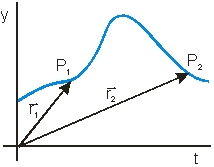
-Which of the vector diagrams below best represent the velocity vector at P1 and P2?
A) (1)
B) (2)
C) (3)
D) (4)
E) None of these is correct.
The curve shows the position of an object with time. The object moves with a constant speed, v.

-Which of the vector diagrams below best represent the velocity vector at P1 and P2?

A) (1)
B) (2)
C) (3)
D) (4)
E) None of these is correct.

Unlock Deck
Unlock for access to all 67 flashcards in this deck.
Unlock Deck
k this deck
10
The position vector of an object is given by  and 4 s later, its position vector is
and 4 s later, its position vector is  . The units are in m. The change in the position vector
. The units are in m. The change in the position vector  , in m, is
, in m, is
A)
B)
C)
D)
E) None of the above
 and 4 s later, its position vector is
and 4 s later, its position vector is  . The units are in m. The change in the position vector
. The units are in m. The change in the position vector  , in m, is
, in m, isA)

B)

C)

D)

E) None of the above

Unlock Deck
Unlock for access to all 67 flashcards in this deck.
Unlock Deck
k this deck
11
A car is traveling south at 30 km/h. It rounds a curve, and 6 s later it is traveling west at 30 km/h. The magnitude of the average acceleration of the car is
A) zero
B) 60 km/h · s
C) 5 km/h · s
D) 50 km/h · s
E) 7.1 km/h · s
A) zero
B) 60 km/h · s
C) 5 km/h · s
D) 50 km/h · s
E) 7.1 km/h · s

Unlock Deck
Unlock for access to all 67 flashcards in this deck.
Unlock Deck
k this deck
12
The position vector locating the point P(5,12) relative to the origin is
A) 12 + 5
+ 5 
B) -5 - 12
- 12 
C) 5 + 12
+ 12 
D) 13 + 13
+ 13 
E) 13 - 13
- 13 
A) 12
 + 5
+ 5 
B) -5
 - 12
- 12 
C) 5
 + 12
+ 12 
D) 13
 + 13
+ 13 
E) 13
 - 13
- 13 

Unlock Deck
Unlock for access to all 67 flashcards in this deck.
Unlock Deck
k this deck
13
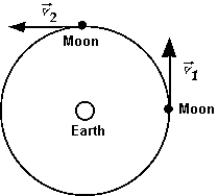 The figure shows the position of the moon at two times, about 7 days apart. Which vector best represents the change in the moon's velocity in this time interval?
The figure shows the position of the moon at two times, about 7 days apart. Which vector best represents the change in the moon's velocity in this time interval?A)

B)

C)

D)

E)


Unlock Deck
Unlock for access to all 67 flashcards in this deck.
Unlock Deck
k this deck
14
The initial path of a rocket is 30º above the horizontal, and the horizontal component of the rocket's velocity is 326 m/s. The initial vertical component of the rocket's velocity is
A) 188 m/s
B) 330 m/s
C) 380 m/s
D) 280 m/s
E) 250 m/s
A) 188 m/s
B) 330 m/s
C) 380 m/s
D) 280 m/s
E) 250 m/s

Unlock Deck
Unlock for access to all 67 flashcards in this deck.
Unlock Deck
k this deck
15
You walk 5 km north and then 12 km east. Your resultant displacement is
A) 13 km at an angle of 22.6º north of east.
B) 13 km at an angle of 67.4º north of east.
C) 17 km at an angle of 22.6º north of east.
D) 17 km at an angle of 67.4º north of east.
E) None of these is correct.
A) 13 km at an angle of 22.6º north of east.
B) 13 km at an angle of 67.4º north of east.
C) 17 km at an angle of 22.6º north of east.
D) 17 km at an angle of 67.4º north of east.
E) None of these is correct.

Unlock Deck
Unlock for access to all 67 flashcards in this deck.
Unlock Deck
k this deck
16
The position vector of an object is given by  and 4 s later, its position vector is
and 4 s later, its position vector is  . The units are in m. The magnitude of the change in the position vector
. The units are in m. The magnitude of the change in the position vector  is
is
A) 0 m
B) m
m
C) m
m
D) 10 m
E) m
m
 and 4 s later, its position vector is
and 4 s later, its position vector is  . The units are in m. The magnitude of the change in the position vector
. The units are in m. The magnitude of the change in the position vector  is
isA) 0 m
B)
 m
mC)
 m
mD) 10 m
E)
 m
m
Unlock Deck
Unlock for access to all 67 flashcards in this deck.
Unlock Deck
k this deck
17
Use the diagram to answer question.
The curve shows the position of an object with time. The object moves with a constant speed, v.
Which of the vector diagrams below best represent the change in position vector from P1 to P2?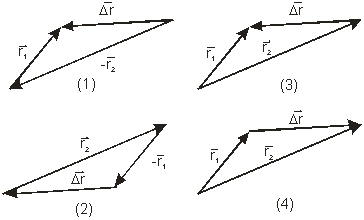
A) (1)
B) (2)
C) (3)
D) (4)
E) None of these is correct.
The curve shows the position of an object with time. The object moves with a constant speed, v.

Which of the vector diagrams below best represent the change in position vector from P1 to P2?

A) (1)
B) (2)
C) (3)
D) (4)
E) None of these is correct.

Unlock Deck
Unlock for access to all 67 flashcards in this deck.
Unlock Deck
k this deck
18
Use the diagram to answer question.
The curve shows the position of an object with time. The object moves with a constant speed, v.
Which of the vector diagrams below best represent the change in velocity vector from P1 to P2?
A) (1)
B) (2)
C) (3)
D) (4)
E) None of these is correct.
The curve shows the position of an object with time. The object moves with a constant speed, v.

Which of the vector diagrams below best represent the change in velocity vector from P1 to P2?

A) (1)
B) (2)
C) (3)
D) (4)
E) None of these is correct.

Unlock Deck
Unlock for access to all 67 flashcards in this deck.
Unlock Deck
k this deck
19
The position vector locating the point P(12,-5) relative to the origin is
A) 12 + 5
+ 5 
B) -5 - 12
- 12 
C) 5 + 12
+ 12 
D) 12 + 5
+ 5 
E) 13 - 13
- 13 
A) 12
 + 5
+ 5 
B) -5
 - 12
- 12 
C) 5
 + 12
+ 12 
D) 12
 + 5
+ 5 
E) 13
 - 13
- 13 

Unlock Deck
Unlock for access to all 67 flashcards in this deck.
Unlock Deck
k this deck
20
If an object is moving west, its acceleration
A) is north.
B) is east.
C) is west.
D) is south.
E) may be any direction.
A) is north.
B) is east.
C) is west.
D) is south.
E) may be any direction.

Unlock Deck
Unlock for access to all 67 flashcards in this deck.
Unlock Deck
k this deck
21
An airplane is heading due east. The airspeed indicator shows that the plane is moving at a speed of 370 km/h relative to the air. If the wind is blowing from the south at 92.5 km/h, the velocity of the airplane relative to the ground is
A) 357 km/h at 14º east of north.
B) 381 km/h at 104º east of north.
C) 381 km/h at 76º east of north.
D) 357 km/h at 76º east of north.
E) 381 km/h at 14º east of north.
A) 357 km/h at 14º east of north.
B) 381 km/h at 104º east of north.
C) 381 km/h at 76º east of north.
D) 357 km/h at 76º east of north.
E) 381 km/h at 14º east of north.

Unlock Deck
Unlock for access to all 67 flashcards in this deck.
Unlock Deck
k this deck
22
A train, starting from rest, accelerates along the platform at a uniform rate of 0.6 m/s2. A passenger standing on the platform is 5 m away from the door when the train starts to pull away and heads toward the door at acceleration of 1.2 m/s2. How far away from the door is the passenger after 3 seconds?
A) 2.7 m
B) 5.4 m
C) 0.40 m
D) 2.3 m
E) 0.90 m
A) 2.7 m
B) 5.4 m
C) 0.40 m
D) 2.3 m
E) 0.90 m

Unlock Deck
Unlock for access to all 67 flashcards in this deck.
Unlock Deck
k this deck
23
A pilot wants the heading of an airplane to be 45º east of north. The wind is from 270º at 32 km/h, and the speed of the airplane through the air is 320 km/h. The pilot should maintain a heading of approximately
A) 15º
B) 49º
C) 41º
D) 4º
E) 131º
A) 15º
B) 49º
C) 41º
D) 4º
E) 131º

Unlock Deck
Unlock for access to all 67 flashcards in this deck.
Unlock Deck
k this deck
24
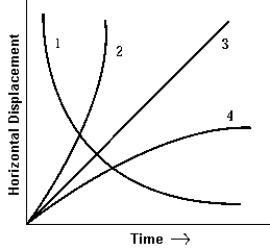 A projectile is fired at an angle of 45º above the horizontal. If air resistance is neglected, the line in the graph that best represents the horizontal displacement of the projectile as a function of travel time is
A projectile is fired at an angle of 45º above the horizontal. If air resistance is neglected, the line in the graph that best represents the horizontal displacement of the projectile as a function of travel time isA) 1
B) 2
C) 3
D) 4
E) None of these is correct.

Unlock Deck
Unlock for access to all 67 flashcards in this deck.
Unlock Deck
k this deck
25
A stone with a mass m is dropped from an airplane that has a horizontal velocity v at a height h above a lake. If air resistance is neglected, the horizontal distance R from the point on the lake directly below the point of release to the point where the stone strikes the water is given by which formula?
A) R = v(2h/g)2
B) R = (1/2)gt2
C)
D)
E) None of these is correct.
A) R = v(2h/g)2
B) R = (1/2)gt2
C)

D)

E) None of these is correct.

Unlock Deck
Unlock for access to all 67 flashcards in this deck.
Unlock Deck
k this deck
26
A car is at position (x1, y1) = (4 m, 5 m) at time t1 = 1 s. If 10 seconds later the car moving in a straight line is at position (x2, y2) = (204 m, 305 m), find the (size of the) component of the average velocity along the x-axis.
A) 30.0 m/s
B) 36.1 m/s
C) 20.0 m/s
D) 18.2 m/s
E) 22.2 m/s
A) 30.0 m/s
B) 36.1 m/s
C) 20.0 m/s
D) 18.2 m/s
E) 22.2 m/s

Unlock Deck
Unlock for access to all 67 flashcards in this deck.
Unlock Deck
k this deck
27
A train, starting from rest, accelerates along the platform at a uniform rate of 0.6 m/s2. A passenger standing on the platform is 5 m away from the door when the train starts to pull away and heads toward the door at an acceleration of 1.2 m/s2. How long does it take the passenger to reach the door?
A) 3.0 s
B) 17 s
C) 7.1 s
D) 5.6 s
E) 4.1 s
A) 3.0 s
B) 17 s
C) 7.1 s
D) 5.6 s
E) 4.1 s

Unlock Deck
Unlock for access to all 67 flashcards in this deck.
Unlock Deck
k this deck
28
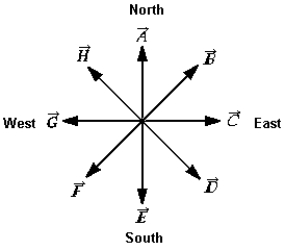 An automobile is moving toward the east at 50 km/h, and the wind is from the north at 50 km/h. Which vector in the figure represents the wind velocity as observed by a passenger in the car?
An automobile is moving toward the east at 50 km/h, and the wind is from the north at 50 km/h. Which vector in the figure represents the wind velocity as observed by a passenger in the car?A)

B)

C)

D)

E)


Unlock Deck
Unlock for access to all 67 flashcards in this deck.
Unlock Deck
k this deck
29
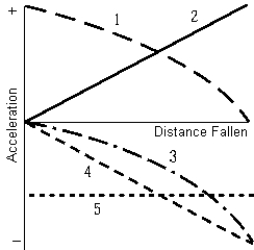 A ball is thrown horizontally from a cliff with a velocity
A ball is thrown horizontally from a cliff with a velocity  0. A graph of the acceleration of the ball versus the distance fallen could be represented by curve
0. A graph of the acceleration of the ball versus the distance fallen could be represented by curveA) 1
B) 2
C) 3
D) 4
E) 5

Unlock Deck
Unlock for access to all 67 flashcards in this deck.
Unlock Deck
k this deck
30
A plane is flying horizontally at a height of 500 m and a constant speed of 429 km/h when an object is projected vertically downward at an initial speed of 35.0 m/s. If air resistance is neglected, the average vertical component of velocity between the object's release and its striking the ground is
A) 70.0 m/s
B) 5.50 103 m/s
C) 140 m/s
D) 105 m/s
E) 35.0 m/s
A) 70.0 m/s
B) 5.50 103 m/s
C) 140 m/s
D) 105 m/s
E) 35.0 m/s

Unlock Deck
Unlock for access to all 67 flashcards in this deck.
Unlock Deck
k this deck
31
The maximum horizontal range of a rock which is thrown at the same speed but different angles with the horizon and which lands at a level, H, below the initial level occurs when the angle is
A) less than 0
B) 0
C) greater than 0 and less than 45 (actual value depends on the value of H)
D) 45
E) greater than 45
A) less than 0
B) 0
C) greater than 0 and less than 45 (actual value depends on the value of H)
D) 45
E) greater than 45

Unlock Deck
Unlock for access to all 67 flashcards in this deck.
Unlock Deck
k this deck
32
A projectile is fired with an initial speed of 1000 m/s at an angle of 37º above the horizontal. If air resistance is neglected, the horizontal component of the projectile's velocity after 20 s is approximately
A) 600 m/s
B) 800 m/s
C) 640 m/s
D) 40 m/s
E) 160 m/s
A) 600 m/s
B) 800 m/s
C) 640 m/s
D) 40 m/s
E) 160 m/s

Unlock Deck
Unlock for access to all 67 flashcards in this deck.
Unlock Deck
k this deck
33
A pilot wants the heading of an airplane to be 37º east of north. The wind is from the east at 37 km/h. The airplane has a speed relative to the air of 370 km/h. Approximately what heading should the pilot maintain? ( Sketch the problem graphically and select the best answer from the list given.)
A) 318º
B) 4.6º
C) 122º
D) 32º
E) 42º
A) 318º
B) 4.6º
C) 122º
D) 32º
E) 42º

Unlock Deck
Unlock for access to all 67 flashcards in this deck.
Unlock Deck
k this deck
34
If a baseball is thrown at an angle of elevation of 30º, its range in the absence of air resistance is less than that of one thrown at
A) 0º
B) 80º
C) 20º
D) 55º
E) 90º
A) 0º
B) 80º
C) 20º
D) 55º
E) 90º

Unlock Deck
Unlock for access to all 67 flashcards in this deck.
Unlock Deck
k this deck
35
A projectile is shot at an angle of 45º to the horizontal near the surface of Earth but in the absence of air resistance. When it reaches the highest point of its trajectory, its speed is 150 m/s. In a second trial with the same projectile, the initial speed is the same but the angle is now 37º with the horizontal. At its highest point in this trajectory, the speed of the projectile would be
A) 150 m/s (sin 45º/sin 36º)
B) 150 m/s (cos 37º/cos 45º)
C) 150 m/s (sin 37º/sin 45º)
D) 150 m/s (37/45)
E) None of these is correct.
A) 150 m/s (sin 45º/sin 36º)
B) 150 m/s (cos 37º/cos 45º)
C) 150 m/s (sin 37º/sin 45º)
D) 150 m/s (37/45)
E) None of these is correct.

Unlock Deck
Unlock for access to all 67 flashcards in this deck.
Unlock Deck
k this deck
36
Which of the following statements is not true of a projectile moving near the surface of the earth against negligible air resistance?
A) The horizontal velocity is constant.
B) The vertical acceleration is constant.
C) The horizontal displacement is directly proportional to the time of flight.
D) The vertical velocity at any given time is independent of the angle of projection.
E) The horizontal acceleration is constant.
A) The horizontal velocity is constant.
B) The vertical acceleration is constant.
C) The horizontal displacement is directly proportional to the time of flight.
D) The vertical velocity at any given time is independent of the angle of projection.
E) The horizontal acceleration is constant.

Unlock Deck
Unlock for access to all 67 flashcards in this deck.
Unlock Deck
k this deck
37
A baseball is thrown with a velocity  at an angle with the horizontal. The horizontal component of its velocity in the absence of air resistance is
at an angle with the horizontal. The horizontal component of its velocity in the absence of air resistance is
A) v cos
B) v cos - gt
C) v2 + 2gx
D) v2 - 2gx
E) v sin - gt
 at an angle with the horizontal. The horizontal component of its velocity in the absence of air resistance is
at an angle with the horizontal. The horizontal component of its velocity in the absence of air resistance isA) v cos
B) v cos - gt
C) v2 + 2gx
D) v2 - 2gx
E) v sin - gt

Unlock Deck
Unlock for access to all 67 flashcards in this deck.
Unlock Deck
k this deck
38
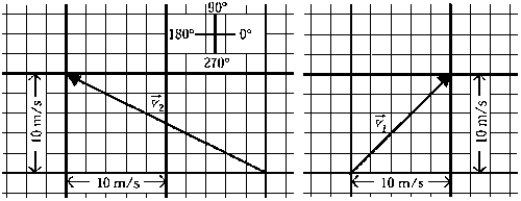 The instantaneous velocity of a particle at t1 is represented by
The instantaneous velocity of a particle at t1 is represented by  1, and at t2 by
1, and at t2 by  2. Each heavy graph division is 10 m/s on each side. Let t1 = 1 s and t2 = 7 s. Then the average acceleration of the particle between time t1 and t2 is
2. Each heavy graph division is 10 m/s on each side. Let t1 = 1 s and t2 = 7 s. Then the average acceleration of the particle between time t1 and t2 isA) 18.2 m/s2 at 0º
B) 15.0 m/s2 at 180º
C) 6.06 m/s2 at 98º
D) 5.00 m/s2 at 180º
E) 3.03 m/s2 at 98º

Unlock Deck
Unlock for access to all 67 flashcards in this deck.
Unlock Deck
k this deck
39
A car is at position (x1, y1) = (4 m, 5 m) at time t1 = 1 s. If 10 seconds later the car moving in a straight line is at position (x2, y2) = (204 m, 305 m), calculate the magnitude of the average velocity during this interval.
A) 36.1 m/s
B) 32.8 m/s
C) 36.7 m/s
D) 50.0 m/s
E) 40.1 m/s
A) 36.1 m/s
B) 32.8 m/s
C) 36.7 m/s
D) 50.0 m/s
E) 40.1 m/s

Unlock Deck
Unlock for access to all 67 flashcards in this deck.
Unlock Deck
k this deck
40
A car is at position (x1, y1) = (4 m, 5 m) at time t1 = 1 s. If 10 seconds later the car moving in a straight line is at position (x2, y2) = (204 m, 305 m), calculate the distance traveled by the car in this interval.
A) 367 m
B) 500 m
C) 373 m
D) 509 m
E) 361 m
A) 367 m
B) 500 m
C) 373 m
D) 509 m
E) 361 m

Unlock Deck
Unlock for access to all 67 flashcards in this deck.
Unlock Deck
k this deck
41
Use the figure to answer questions
The figure represents the parabolic trajectory of a ball going from a to e in Earth gravity but without air resistance. The initial velocity of the ball is Vo at an angle θ to the horizon. The vertical dashed lines represent equal time interval, Δt.
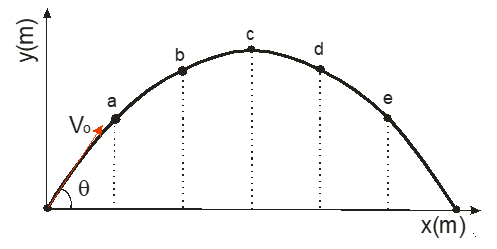
-The horizontal velocity at point c is
A) 0
B) Vo cos ( )
C) Vo sin ( )
D) Vo
E) depends on what g is along the path
The figure represents the parabolic trajectory of a ball going from a to e in Earth gravity but without air resistance. The initial velocity of the ball is Vo at an angle θ to the horizon. The vertical dashed lines represent equal time interval, Δt.

-The horizontal velocity at point c is
A) 0
B) Vo cos ( )
C) Vo sin ( )
D) Vo
E) depends on what g is along the path

Unlock Deck
Unlock for access to all 67 flashcards in this deck.
Unlock Deck
k this deck
42
Use the following to answer question : 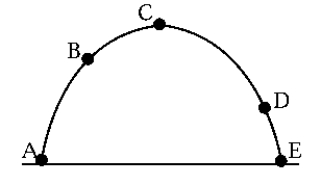
The figure represents the parabolic trajectory of a ball going from A to E in Earth gravity but without air resistance. What is the direction of the acceleration at point C?
A) it is to the right
B) it is to the left
C) it is straight up
D) it is straight down
E) The acceleration of the ball is zero

The figure represents the parabolic trajectory of a ball going from A to E in Earth gravity but without air resistance. What is the direction of the acceleration at point C?
A) it is to the right
B) it is to the left
C) it is straight up
D) it is straight down
E) The acceleration of the ball is zero

Unlock Deck
Unlock for access to all 67 flashcards in this deck.
Unlock Deck
k this deck
43
Use the following to answer question 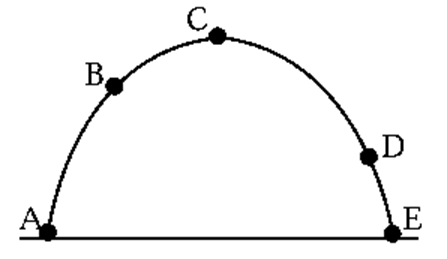
-The figure represents the parabolic trajectory of a ball going from A to E. What is the speed at point C compared with that at point A?
A) It is greater at C than at A
B) It is less at C than at A
C) The speeds are identical
D) The speeds are both zero
E) It is not possible to answer this question without more information.

-The figure represents the parabolic trajectory of a ball going from A to E. What is the speed at point C compared with that at point A?
A) It is greater at C than at A
B) It is less at C than at A
C) The speeds are identical
D) The speeds are both zero
E) It is not possible to answer this question without more information.

Unlock Deck
Unlock for access to all 67 flashcards in this deck.
Unlock Deck
k this deck
44
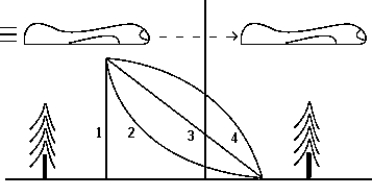 An airplane in horizontal flight releases a relief package as shown in the diagram. The trajectory of the package is best represented by
An airplane in horizontal flight releases a relief package as shown in the diagram. The trajectory of the package is best represented byA) 1
B) 2
C) 3
D) 4
E) None of these is correct.

Unlock Deck
Unlock for access to all 67 flashcards in this deck.
Unlock Deck
k this deck
45
A projectile is ejected from a 25-m high tower with a velocity of 40 m/s at an angle of 30 degrees to the horizontal first on Earth and then on Mars. What is the ratio of the time taken to hit the ground on Mars compared to Earth? (Assume gMars = 0.38gEarth)
A) 2.4
B) 2.6
C) 0.38
D) 6.9
E) 1.0
A) 2.4
B) 2.6
C) 0.38
D) 6.9
E) 1.0

Unlock Deck
Unlock for access to all 67 flashcards in this deck.
Unlock Deck
k this deck
46
Mark throws a ball to Daniel with an initial speed of 20 m/s at an angle of 45 degrees. If they are initially 55 m apart, calculate the average speed Daniel has to run to catch the ball. (Assume the ball is thrown and caught at the same height. Also assume that Daniel starts to run when the ball is thrown.)
A) 19 m/s
B) 14 m/s
C) 4.9 m/s
D) 9.1 m/s
E) 2.9 m/s
A) 19 m/s
B) 14 m/s
C) 4.9 m/s
D) 9.1 m/s
E) 2.9 m/s

Unlock Deck
Unlock for access to all 67 flashcards in this deck.
Unlock Deck
k this deck
47
A naughty squirrel jumps from a tree limb onto a birdfeeder. The tree limb is 4.5 m above the ground and the top of the birdfeeder is 1.5 m above the ground. If the squirrel jumps horizontally with a velocity of 2.5 m/s then how far away in the horizontal direction can the bird feeder be for the squirrel to just make it onto the top of the feeder.
A) 3.6 m
B) 2.0 m
C) 2.4 m
D) 1.5 m
E) 1.4 m
A) 3.6 m
B) 2.0 m
C) 2.4 m
D) 1.5 m
E) 1.4 m

Unlock Deck
Unlock for access to all 67 flashcards in this deck.
Unlock Deck
k this deck
48
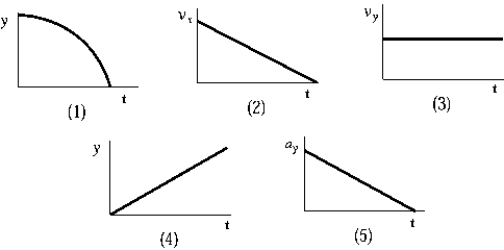 A projectile is fired horizontally in Earth gravity with an initial speed v0. In the absence of air resistance, which of the following graphs is representative of the projectile's motion?
A projectile is fired horizontally in Earth gravity with an initial speed v0. In the absence of air resistance, which of the following graphs is representative of the projectile's motion?A) 1
B) 2
C) 3
D) 4
E) 5

Unlock Deck
Unlock for access to all 67 flashcards in this deck.
Unlock Deck
k this deck
49
A roofing tile slides down a roof and falls off the roof edge 10 m above the ground at a speed of 6 m/s. The roof makes an angle of 30 degrees to the horizontal. How far from the exit point on the roof does the tile land?
A) 6.00 m
B) 16.0 m
C) 11.7 m
D) 13.6 m
E) 19.2 m
A) 6.00 m
B) 16.0 m
C) 11.7 m
D) 13.6 m
E) 19.2 m

Unlock Deck
Unlock for access to all 67 flashcards in this deck.
Unlock Deck
k this deck
50
A projectile was fired at 35º above the horizontal. At the highest point in its trajectory its speed was 200 m/s. If air resistance is ignored, the initial velocity had a horizontal component of
A) zero
B) 200 cos (35º) m/s
C) 200 sin (35º) m/s
D) 200/cos (35º) m/s
E) 200 m/s
A) zero
B) 200 cos (35º) m/s
C) 200 sin (35º) m/s
D) 200/cos (35º) m/s
E) 200 m/s

Unlock Deck
Unlock for access to all 67 flashcards in this deck.
Unlock Deck
k this deck
51
If air resistance is neglected and the initial speed of a projectile is doubled, its range
A) doubles.
B) decreases by one-half.
C) increases by a factor of four.
D) decreases by a factor of four.
E) does not change.
A) doubles.
B) decreases by one-half.
C) increases by a factor of four.
D) decreases by a factor of four.
E) does not change.

Unlock Deck
Unlock for access to all 67 flashcards in this deck.
Unlock Deck
k this deck
52
Use the figure to answer questions
The figure represents the parabolic trajectory of a ball going from a to e in Earth gravity but without air resistance. The initial velocity of the ball is Vo at an angle θ to the horizon. The vertical dashed lines represent equal time interval, Δt.

-The acceleration at point a is ____ the acceleration at c is
A) less than
B) equal to
C) greater than
D) unable to tell
E) depends on how g changes along the path
The figure represents the parabolic trajectory of a ball going from a to e in Earth gravity but without air resistance. The initial velocity of the ball is Vo at an angle θ to the horizon. The vertical dashed lines represent equal time interval, Δt.

-The acceleration at point a is ____ the acceleration at c is
A) less than
B) equal to
C) greater than
D) unable to tell
E) depends on how g changes along the path

Unlock Deck
Unlock for access to all 67 flashcards in this deck.
Unlock Deck
k this deck
53
If you ignore air resistance in projectile motion, the ________ of the projectile remains constant.
A) velocity vector
B) horizontal component of the velocity vector
C) vertical component of the velocity vector
D) speed
E) range
A) velocity vector
B) horizontal component of the velocity vector
C) vertical component of the velocity vector
D) speed
E) range

Unlock Deck
Unlock for access to all 67 flashcards in this deck.
Unlock Deck
k this deck
54
A particle initially moving at 4.0 m/s along the x axis is uniformly accelerated at 3.0 m/s2 along the y axis for 2.0 s. The final speed of the particle is
A) -2.0 m/s
B) 8.2 m/s
C) 6.0 m/s
D) 10 m/s
E) None of these is correct.
A) -2.0 m/s
B) 8.2 m/s
C) 6.0 m/s
D) 10 m/s
E) None of these is correct.

Unlock Deck
Unlock for access to all 67 flashcards in this deck.
Unlock Deck
k this deck
55
You shoot an arrow in a high arc toward a target located some distance away. At the highest point in its flight, the arrow's
A) velocity and acceleration are both nonzero.
B) velocity is zero but its acceleration is nonzero.
C) velocity is nonzero but its acceleration is zero.
D) velocity and acceleration are both zero.
E) Insufficient information is given to answer correctly.
A) velocity and acceleration are both nonzero.
B) velocity is zero but its acceleration is nonzero.
C) velocity is nonzero but its acceleration is zero.
D) velocity and acceleration are both zero.
E) Insufficient information is given to answer correctly.

Unlock Deck
Unlock for access to all 67 flashcards in this deck.
Unlock Deck
k this deck
56
Use the following to answer question : 
The figure represents the parabolic trajectory of a ball going from A to E in Earth gravity but without air resistance. At point C the velocity of the ball is
A) a maximum and is directed to the right
B) directed to the left
C) a maximum
D) a minimum and is directed to the right
E) zero

The figure represents the parabolic trajectory of a ball going from A to E in Earth gravity but without air resistance. At point C the velocity of the ball is
A) a maximum and is directed to the right
B) directed to the left
C) a maximum
D) a minimum and is directed to the right
E) zero

Unlock Deck
Unlock for access to all 67 flashcards in this deck.
Unlock Deck
k this deck
57
A golfer drives her ball from the tee down the fairway in a high arcing shot. When the ball is at the highest point of its flight,
A) its velocity and acceleration are both zero.
B) its velocity is zero but its acceleration is nonzero.
C) its velocity is nonzero but its acceleration is zero.
D) its velocity and acceleration are both nonzero.
E) Insufficient information is given to answer correctly.
A) its velocity and acceleration are both zero.
B) its velocity is zero but its acceleration is nonzero.
C) its velocity is nonzero but its acceleration is zero.
D) its velocity and acceleration are both nonzero.
E) Insufficient information is given to answer correctly.

Unlock Deck
Unlock for access to all 67 flashcards in this deck.
Unlock Deck
k this deck
58
A rescue airplane is diving at an angle of 37º below the horizontal with a speed of 250 m/s. It releases a survival package when it is at an altitude of 600 m. If air resistance is ignored, the horizontal distance of the point of impact from the plane at the moment of the package's release is
A) 2.80 103 m
B) 720 m
C) 6.80 103 m
D) 420 m
E) 5.50 103 m
A) 2.80 103 m
B) 720 m
C) 6.80 103 m
D) 420 m
E) 5.50 103 m

Unlock Deck
Unlock for access to all 67 flashcards in this deck.
Unlock Deck
k this deck
59
Use the following to answer question : 
The figure represents the parabolic trajectory of a ball going from A to E in Earth gravity but without air resistance. What is the direction of the acceleration at point B?
A) it is up and to the right
B) it is down and to the left
C) it is straight up
D) it is straight down
E) The acceleration of the ball is zero

The figure represents the parabolic trajectory of a ball going from A to E in Earth gravity but without air resistance. What is the direction of the acceleration at point B?
A) it is up and to the right
B) it is down and to the left
C) it is straight up
D) it is straight down
E) The acceleration of the ball is zero

Unlock Deck
Unlock for access to all 67 flashcards in this deck.
Unlock Deck
k this deck
60
Use the figure to answer questions
The figure represents the parabolic trajectory of a ball going from a to e in Earth gravity but without air resistance. The initial velocity of the ball is Vo at an angle θ to the horizon. The vertical dashed lines represent equal time interval, Δt.

-The vertical velocity at point b is: Note: (g = 9.81 m/s2)
A) 0
B) Vo cos ( ) - ½ g (2 t)2
C) Vo sin ( ) - ½ g (2 t)2
D) Vo sin ( ) + ½ g (2 t)2
E) Vo cos ( ) + ½ g (2 t)2
The figure represents the parabolic trajectory of a ball going from a to e in Earth gravity but without air resistance. The initial velocity of the ball is Vo at an angle θ to the horizon. The vertical dashed lines represent equal time interval, Δt.

-The vertical velocity at point b is: Note: (g = 9.81 m/s2)
A) 0
B) Vo cos ( ) - ½ g (2 t)2
C) Vo sin ( ) - ½ g (2 t)2
D) Vo sin ( ) + ½ g (2 t)2
E) Vo cos ( ) + ½ g (2 t)2

Unlock Deck
Unlock for access to all 67 flashcards in this deck.
Unlock Deck
k this deck
61
A merry-go-round completes one revolution in 30 s. What is the speed of a rider located at a distance 3 m from the center of the merry go-round?
A) 0.1 m/s
B) 0.2 m/s
C) 2 m/s
D) 6 m/s
E) 30 m/s
A) 0.1 m/s
B) 0.2 m/s
C) 2 m/s
D) 6 m/s
E) 30 m/s

Unlock Deck
Unlock for access to all 67 flashcards in this deck.
Unlock Deck
k this deck
62
A merry-go-round completes one revolution in 40 s. What is the centripetal acceleration of a rider located at a distance 2 m from the center of the merry go-round?
A) m/s2
m/s2
B) m/s2
m/s2
C) 2/200 m/s2
D) 2/100 m/s2
E) 2 m/s2
A)
 m/s2
m/s2B)
 m/s2
m/s2C) 2/200 m/s2
D) 2/100 m/s2
E) 2 m/s2

Unlock Deck
Unlock for access to all 67 flashcards in this deck.
Unlock Deck
k this deck
63
A ball is whirled in a horizontal circle of radius r and speed v. The radius is increased to 2r keeping the speed of the ball constant. The period of the ball changes by a factor of
A) half
B) one
C) two
D) three
E) four
A) half
B) one
C) two
D) three
E) four

Unlock Deck
Unlock for access to all 67 flashcards in this deck.
Unlock Deck
k this deck
64
The figure shows the position of a ball as it is being whirled in a vertical circle. 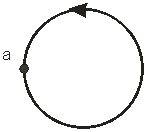 At point (a), the direction of the resultant acceleration (centripetal and tangential) is
At point (a), the direction of the resultant acceleration (centripetal and tangential) is
A)
B)
C)
D)
E)
 At point (a), the direction of the resultant acceleration (centripetal and tangential) is
At point (a), the direction of the resultant acceleration (centripetal and tangential) is A)

B)

C)

D)

E)


Unlock Deck
Unlock for access to all 67 flashcards in this deck.
Unlock Deck
k this deck
65
The initial position and velocity of a projectile are given by  and
and  respectively, and where r is in m and v in m/s. The position in the vertical direction (in m) as a function of time is
respectively, and where r is in m and v in m/s. The position in the vertical direction (in m) as a function of time is
A) y(t) = 6t
B) y(t) = 3 + 6t
C) y(t) = 3 + 6t + gt2
gt2
D) y(t) = 4 + 8t
E) y(t) = 4 + 8t + gt2
gt2
 and
and  respectively, and where r is in m and v in m/s. The position in the vertical direction (in m) as a function of time is
respectively, and where r is in m and v in m/s. The position in the vertical direction (in m) as a function of time isA) y(t) = 6t
B) y(t) = 3 + 6t
C) y(t) = 3 + 6t +
 gt2
gt2D) y(t) = 4 + 8t
E) y(t) = 4 + 8t +
 gt2
gt2
Unlock Deck
Unlock for access to all 67 flashcards in this deck.
Unlock Deck
k this deck
66
The initial position and velocity of a projectile are given by  and
and  respectively, and where r is in m and v in m/s. The position in the horizontal direction (in m) as a function of time is
respectively, and where r is in m and v in m/s. The position in the horizontal direction (in m) as a function of time is
A) x(t) = 6t
B) x(t) = 3 + 6t
C) x(t) = 3 + 6t + gt2
gt2
D) x(t) = 4 + 8t
E) x(t) = 4 + 8t + gt2
gt2
 and
and  respectively, and where r is in m and v in m/s. The position in the horizontal direction (in m) as a function of time is
respectively, and where r is in m and v in m/s. The position in the horizontal direction (in m) as a function of time isA) x(t) = 6t
B) x(t) = 3 + 6t
C) x(t) = 3 + 6t +
 gt2
gt2D) x(t) = 4 + 8t
E) x(t) = 4 + 8t +
 gt2
gt2
Unlock Deck
Unlock for access to all 67 flashcards in this deck.
Unlock Deck
k this deck
67
A projectile is ejected from a 25-m high tower with a velocity of 40 m/s at an angle of 30 degrees to the horizontal first on Earth and then on Mars. What is the ratio of maximum height above ground level on Mars to Earth (i.e., hmax(Mars) / hmax(Earth))? (Assume gMars = 0.38gEarth)
A) 6.2
B) 0.60
C) 1.1
D) 2.6
E) 1.7
A) 6.2
B) 0.60
C) 1.1
D) 2.6
E) 1.7

Unlock Deck
Unlock for access to all 67 flashcards in this deck.
Unlock Deck
k this deck


